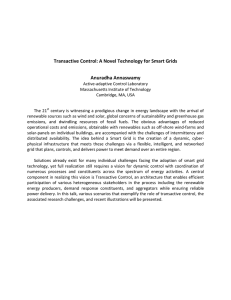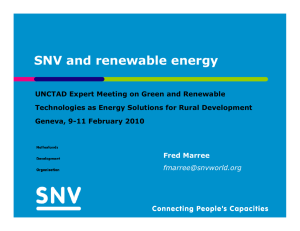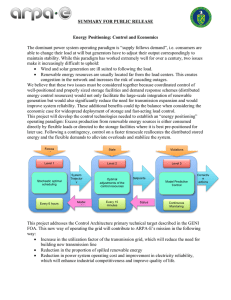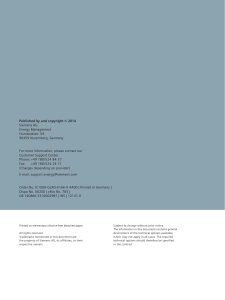Pacific Clean Energy Forum Jim Avery September 1st, 2009 1
advertisement
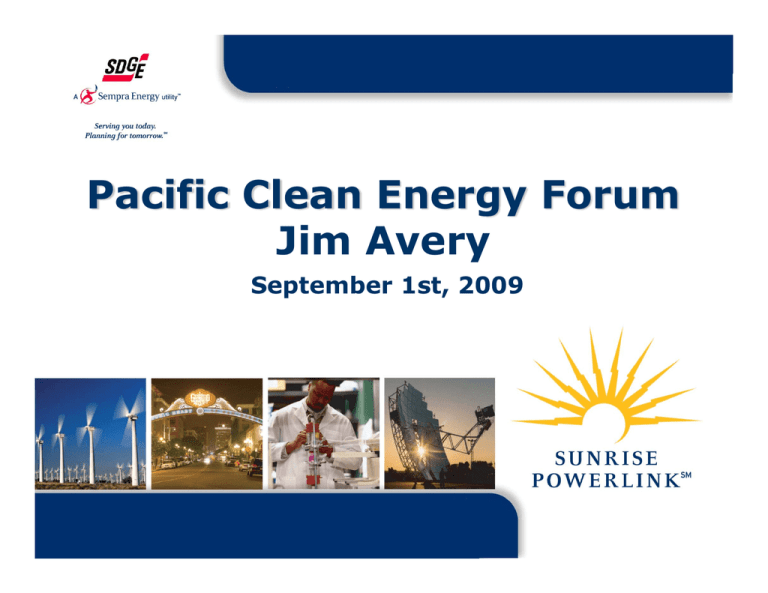
Pacific Clean Energy Forum Jim Avery September 1st, 2009 1 The Role of Transmission in Renewable Development Sunrise Powerlink Case Study 2 Project Description 120-mile electric transmission line from Imperial Valley to San Diego, carrying 1,000 megawatts of power – enough energy for 650,000 homes Extensively reviewed by California Public Utilities Commission (CPUC) and the U.S. Bureau of Land Management (BLM) • Four-year regulatory review process • 5000+ data requests • 43 public hearings • 11,000 page EIR – largest in California history Regulatory approval of Southern Route • CPUC – December 18, 2008 • BLM – January 20, 2009 Project cost -- $1.9 billion Project schedule – 2010 construction start and 2012 in-service 3 4 Sunrise Powerlink Benefits Improves reliability by strengthening the electric transmission grid in California and the Southwestern United States Facilitates development of 1,000 MW of renewable energy potential in the Imperial Valley region Creates “green jobs” in the Imperial Valley, which has one of the highest unemployment rates in the country (26%) Provides over $100 million in net benefits annually to SDG&E customers Project funds provide $190 million to mitigate impacts Demonstrates SDG&E’s leadership supporting clean energy goals • 33% Renewable Portfolio Stand (RPS) by 2020 • Reduce greenhouse gas emissions to 1990 levels by 2020 Creates $1.7 billion in economic investments in the United States and more than $300 million in direct labor expenditures 5 Additional Infrastructure Needed to Tap Region's Expansive Renewable Energy Potential Sunrise Powerlink will link 1,000 MW of a much larger potential supply of renewable energy Experts have identified the San Diego and Imperial Counties, and Baja California Mega-Region as one of the top locations in the country to generate renewable energy Recent studies indicate this Mega-Region has the potential to become a global showcase for clean energy with a potential of nearly 12,000 MW of renewable electricity The renewable energy resources potential: • Solar Energy – 6,550 megawatts Source: Renewable Energy Transmission Initiative (RETI) Phase 2A Draft Resource Report • Wind Energy – 3,495 megawatts including Baja California Sources: RETI Phase 2A Draft Resource Report • Geothermal Energy – 2,000 megawatts Source: Imperial Irrigation District Summit Blue Report 2008 [Note: References are to gross potential without project specific economic analysis] 6 Renewable Potential of San Diego/Salton Sea Region 7 Current Status of Approved Decisions California Public Utilities Commission (CPUC) • January 2009 – Rehearing requests filed by Center for Biological Diversity, Sierra Club and Utility Consumers Action Network (CPCN) • July 2009 – CPUC denies all rehearing requests • Potential legal appeals would be filed in the CA Supreme Court U.S. Bureau of Land Management (BLM) • March 2009 – Appeals filed by Viejas Band of Kumeyaay Indians, south Route opponents and individual activists • June 2009 - Interior Board of Land Appeals (IBLA) rejects appeal of individual activists • July 2009 – IBLA rejects appellants motion to halt all preconstruction and construction activities in its entirety • July 2009 – Viejas voluntarily withdraws appeal • Only one appeal remains – south route activists • Potential legal appeals would be filed in the United States Court of Appeals for the Ninth Circuit 8 Additional Regulatory Permits To Be Obtained Expected July - September 2009 U.S. Forest Service - Plan Amendment, Record of Decision and Special Use Permit Expected Prior to February 2010 Habitat Acquisition Plan Emission Offset Acquisition Federal Water Permits • Army Corps of Engineers Federal Endangered Special Permit • United States Fish and Wildlife Service State Water Permits • California Department of Fish & Game • Water Resources Board State Endangered Species Permit • California Department of Fish & Game 9 Sunrise Powerlink Lessons Learned Obtaining approvals and licenses becoming more difficult • Opposition groups better organized and well funded • Build longer lead times for permitting Transmission siting is more politics than engineering • Public Affairs and community issues are driving projects Engage customers early in route selection process • Gather public input before decisions are made • Develop aggressive outreach program • Be flexible 10 Sunrise Powerlink Lessons Learned Prospect of connecting to renewable resources will not diminish environmental opposition to transmission line • Environmental groups will oppose “green” projects in order to defeat transmission lines • Communities near wind and solar farms are fighting utility-scale projects wind and solar projects 11 The Development of Smart Grid in Renewable Development 12 2-Way Standard Secure Communication The Utility World Tomorrow Today Energy Flow Solar Power Smart Home Smart Meter Smart Office Electric Vehicles Energy Storage Energy Storage 13 Smart Grid Objectives on a Solid Foundation Smart Green Grid Full Deployment Full Scale Deployment Address Renewable Intermittency Secure End-to-End Smart Green Grid Demonstration Objectives Increase Customer Participation Maintain / Improve Reliability Manage Distributed Energy Resources Attain Secure End-to-End integration Demonstration: DOE Beach Cities MicroGrid SDG&E Foundation Demonstration: CEC Smart Grid Pilot Major Implementation: Self-healing grid, OpEx 20/20: WMS, GIS, CBM, OMS/DMS etc. Major Implementation: Advanced Metering Infrastructure (AMI): Smart Meter Deployed in 2011 14

